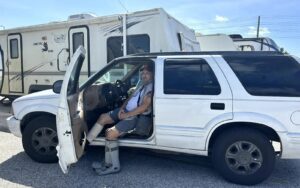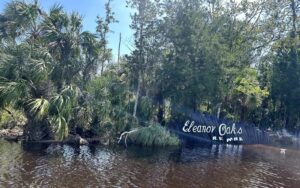This story was originally published by Grist. Sign up for Grist’s weekly newsletter here.
By Jake Bittle and Ayurella Horn-Muller, Grist
In the hours just after Hurricane Helene made landfall on Florida, James Pike sat in his truck, with his mobile home behind him. He was in the parking lot of a grocery store in Inglis, a town of 1,500 people in the state’s rural Big Bend region, waiting alongside dozens of other campers. Trucks rumbled by carrying utility linemen, search and rescue workers, and law enforcement as the displaced residents sat and waited for news.
Pike had moved a few months earlier into a trailer park called Eleanor Oaks, in the neighboring hamlet of Yankeetown, after being priced out of another trailer park on higher ground where he’d ridden out last year’s Hurricane Idalia.
“Eleven in the morning, they said, ‘get out,’ and four in the afternoon, they cut the power,” he said on Friday. “I’m not sure when we’ll be able to get back in.”

Eleanor Oaks was in tatters, submerged by storm surge for the second time in just over a year. Trailers sat bent out of shape or strewn across the lot, left-behind cars and mobile homes were stained with muck, and the whole park stank of sewage.
Rescue crews searched the wreckage of the trailer park and Yankeetown for the dozens of residents who had refused to evacuate. The community is more than 5 miles from the Gulf of Mexico, but the Category 4 storm delivered more than 10 feet of storm surge — pushing water so far inland that it inundated almost all of Yankeetown.
Helene’s powerful eye spared major cities like Tampa and Tallahassee, instead making a direct hit September 26 on Florida’s sparsely developed Big Bend, a largely lower-income part of the state where towns, like Inglis and Yankeetown, are small, many people live in substandard housing, and where local governments have little capacity to aid with rebuilding. There, communities are still recovering from last year’s Hurricane Idalia, which also brought a large storm surge to the region.
“This stuff’s coming in, it’s fierce, and it’s just unstoppable,” Florida Gov. Ron DeSantis said at a press conference Saturday in Dekle Beach. “There’s a lot of damage that we’re seeing here. I remember … I walked the streets after Idalia in some of these areas, but this was like, ‘Wow.’ You see some just complete obliteration for homes.”
As residents such as Pike prepared to return to their campgrounds and homes to start over, they seemed resigned. Robert Thomas, 64, just moved to the Eleanor Oaks trailer park three weeks ago. Thomas has lived in Florida since 2018, making him no stranger to major hurricanes, but this was the first time he’s had to evacuate a place he’s still settling into. With the roads blocked, he doesn’t know when, or if, he’ll be able to return.
“I tried calling over there this morning,” said Thomas, who was waiting with Pike in the grocery store parking lot. “No one answered.”

Florida’s Big Bend has had worse disaster luck than perhaps any other region in the country this decade — so much so that it has earned the moniker “hurricane alley” — but its recovery has taken place largely out of the public eye. Too far from major vacation destinations, rural communities like Inglis and Yankeetown have a track record of navigating extreme weather disasters without much aid from the government, or attention from the rest of the world. A year after Hurricane Idalia, Florida’s top disaster official, praised the fact that the recovery in Big Bend had required relatively little federal spending.
“Obviously $500 million goes a lot farther in a location like the Big Bend than it does in a highly populated area like southwest Florida,” Kevin Guthrie, director of the Florida Division of Emergency Management, said in late August.
But the lack of local resources makes dealing with a hurricane evacuation extremely difficult.
Yankeetown and Inglis deputy fire chief, Kelly Salter, said that the rollercoaster of storms over the past few years has influenced many residents’ decisions about whether to evacuate. Last August, Idalia, also a Category 4, caught many holdouts by surprise. Still reeling from that disaster, residents actually evacuated during the smaller Hurricane Debby earlier this summer, but when Debby produced only a minimal surge, Salter thinks they felt emboldened to resist evacuation orders again.
Helene’s massive circumference — around 400 miles across — fueled its record-breaking storm surge along the Gulf Coast, from Tampa Bay, which saw more than 6 feet of water, up to the beach towns of the Panhandle, which saw close to 20 feet. Yankeetown experienced an estimated 12-foot surge, Salter said, enough to push water up to the windows of homes that had been touched by just a few inches of flooding during Idalia.

Dozens of residents who chose not to evacuate found themselves climbing to their rooftops as the storm roared down upon Levy County, in a desperate attempt to escape the rapidly rising, sewage-riddled waters. In Yankeetown, 20 people had to be rescued. More than half were discovered sequestered on their roofs. Although both towns sit entirely within a FEMA-designated floodplain, only around 300 of their more than combined 1000 households hold flood insurance policies.
“One lady said, ‘Well, I’ve been here for 37 years, nothing has happened,’” said Salter. “And I said, ‘But it did this time, and now you’re putting all of us at risk. Now we have to come and get you because you didn’t do what we told you to do in the first place.’”
Helene is the first hurricane where Salter and her crew had any help from federal and state search and rescue teams.
In the days and weeks to come, the full scope of the damage left by Helene in northwestern Florida’s rural, inland towns will become more clear. What is already obvious is the limited personnel and resources available to help Yankeetown and Inglis rebuild. The budget of Yankeetown is under $4 million, less than the value of some homes in Florida, and its town manager doubles as a local pastor. Salter is not only the deputy fire chief and emergency management coordinator, using a Gmail account for her fire department business, but she also owns a construction company.
“We pretty much have job security here because we have so many hurricanes,” she said.
This article originally appeared in Grist at https://grist.org/extreme-weather/hurricane-helene-yankeetown-florida-evacuation-big-bend-storm-surge/. Banner image: Flooding in Yankeetown from Hurricane Helene (Ayurella Horn-Muller/Grist).
Grist is a nonprofit, independent media organization dedicated to telling stories of climate solutions and a just future. Learn more at Grist.org.
Sign up for The Invading Sea newsletter by visiting here. If you are interested in submitting an opinion piece to The Invading Sea, email Editor Nathan Crabbe at ncrabbe@fau.edu.



